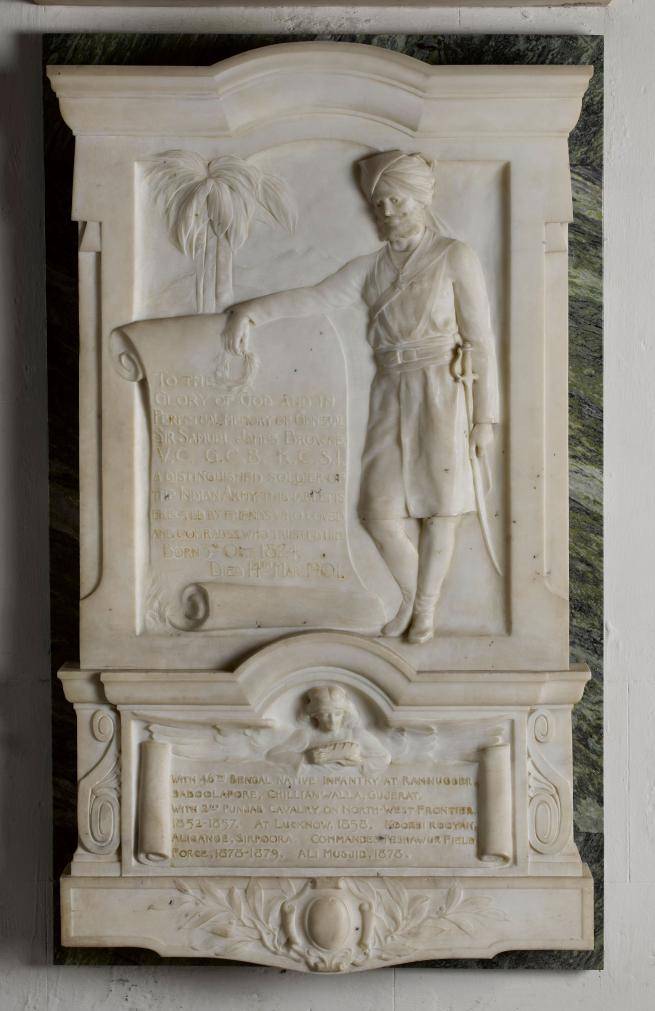Sir Samuel James Browne (1824-1901)

Image courtesy of Pantheons: Sculpture at St Paul's Cathedral.
Sir Samuel James Browne
1824-1901
This work is part of The East India Company at St Paul’s: A digital trail produced in collaboration with Stepney Community Trust.
Written by Monna Matharu, an archive assistant and heritage researcher with the University of East London and the South Asian Diaspora Arts Archive. She leads research, curation and engagement projects which explore the documentation of marginalised narratives, local histories, and heritage spaces; her work also focuses on developing best practices in contemporary record-keeping.
The following text is available in Bengali, Gujurati, Urdu, Hindi, Punjabi, and Tamil. Please email CollectionsDepartment@stpaulscathedral.org.uk to request a copy.

![]()
This memorial presents a Sikh solider mourning Lieutenant Sam Browne.
By 1818, many former empires of the Indian subcontinent had lost their power to the East India Company’s territorial expansion. One frontier still stood strong, the Northwestern Sikh Empire of Maharaja Ranjit Singh. Sikhs were known for their military courage and ability, the distinctive techniques of martial sub-groups called the Nihangs, and their faith in spiritual duty and justice ('miri-piri'). In the early eighteenth century, the guerilla leader Banda Bahadur had challenged the Mughal regime. Heir to that legacy, the Sikh Khalsa army formed the eminent forces of Maharaja Ranjit Singh, one of the last true sovereigns of South Asia. The employment of French and Swiss military experts and the adoption of gunpower made the multi-religious and multi-ethnic army of Sikh Empire army formidable.
The Khalsa army was disbanded with the annexation of the Punjab by the British in 1849. Although the armies of the Sikh Empire fought hard for their freedom in the Second Anglo-Sikh War of 1848-49, they lost nearly ninety thousand square miles as the East India Company extended its conquests toward Afghanistan. The Sikhs in the Punjab had their arms confiscated, their forts destroyed, and their leader Duleep Singh dethroned and exiled. It was a sad event in Sikh memory.
For the East India Company to continue extending its powers in South Asia, the armies of the Sikh Empire were the missing link. As the enemy, the Khalsa army would force the Company to retreat; as a companion, however, the Company would be undefeatable. The British were keen to recruit the Khalsa armies due to their combat abilities and acumen and designated the Sikhs one of the ‘martial races’, alongside the Gurkhas, Pathans, Jats, Punjabi Muslims and others. The colonial authorities, hoping to enlist the Khalsa army, deployed the teachings of Guru Gobind Singh on Sikhism, and offered land and employment to those who would join its forces. The East India Company forces were later absorbed by the British Indian Army, and between 1850 and 1914, Punjabi soldiers, including Sikhs, Punjabi Muslims and Jats, came to form a disproportionately large section of it.
In 1849, Samuel Browne was made a lieutenant and tasked with raising the 2nd Punjab Irregular Cavalry. When Indian soldiers of the East India Company (most of them called 'Poorbia' or Easterners because they were from the eastern part of the subcontinent') rebelled against the Company in 1857, the Sikhs of the 2nd Punjab Irregular Cavalry did not join the uprising, following the command of Browne instead to fight with the East India Company against them. For over two centuries previously, the Sikhs had fought against oppression by the Mughal Empire, and they therefore did not support the Poorbia sepoys’ pact to re-establish a Mughal throne. Many Sikhs must also have resented the Poorbia sepoys who did not support them during the Second Anglo-Sikh war of 1849 but had instead worked for the British to destroy the independent Sikh empire.
The valour of this army did not go unrecognised, and they became legendary in the British imagination. 19 officers and other ranks of the 2nd Punjab Cavalry received a total of 23 Order of Merit awards. An honourable mention went to Jumeeyuyt Singh, the man who saved Browne’s life in the Battle at Seerporah, where Browne famously lost his left arm.
They took part in various British campaigns including Abyssinia (1867–68), Malta (1878–80), Afghanistan (1878–80), Burma (1885), and the epic battle of Saragarhi (1897) in defence of the North-West Frontier Province. The cavalry was again pivotal during the Second Anglo-Afghan War (1878-1880) at the Battle of Ali Masjid, where the army took control through the notorious narrow Khyber Pass. Browne's 2nd Punjab Cavalry was amalgamated with the 25th Cavalry in 1921 to form the 12th Cavalry, which would later fight in both world wars for the British.
For more information on Duleep Singh, refer to the monuments of Sir Lawrence Monument and Sir Charles James Napier.
For detailed information about this monument, visit the Pantheons: Sculpture at St Paul's Cathedral website.

The East India Company at St Paul's
Explore the full digital trail produced in collaboration with Stepney Community Trust.




